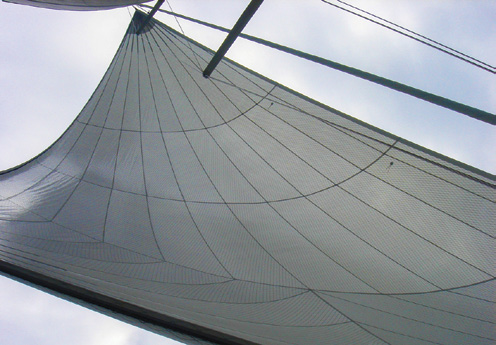By Joe Citarella
 It’s no secret to anyone who sails Long Island Sound that winds during July and August are usually on vacation. The average daylight wind speeds from June to August are the lowest of the year. Sailors know that most of the time you have to wait for the afternoon southwester to get sails filled. Sailing off the wind is particularly challenging (read frustrating) because even when you can get going to windward, when you turn the corner, you sit. Cruisers are typically shorthanded, so setting a symmetrical spinnaker with a pole usually is not practical.
It’s no secret to anyone who sails Long Island Sound that winds during July and August are usually on vacation. The average daylight wind speeds from June to August are the lowest of the year. Sailors know that most of the time you have to wait for the afternoon southwester to get sails filled. Sailing off the wind is particularly challenging (read frustrating) because even when you can get going to windward, when you turn the corner, you sit. Cruisers are typically shorthanded, so setting a symmetrical spinnaker with a pole usually is not practical.
© Z Sails
My son and I recently purchased a Jeanneau 36i from Eastern Yacht Sales in Stamford, CT that has a 130% jib. The tracks do not allow for anything bigger, so we thought about a cruising chute. The Jeanneau is like many newer boats that have smaller fractional jibs measuring less than 130%, which means that keeping the boat moving in low wind speeds is challenging.
One popular option I discussed with Chris Wentz at Z Sails in Stamford is the asymmetrical cruising chute – no spinnaker pole required. However if you are short on crew, setting and snuffing the chute can be a one-armed paperhanger drill. Some cruisers will turn to their engines in light winds. I’d rather sail. After some discussion with Chris on alternatives, we settled on a Code Zero jib (also sometimes called a JibTop), an increasingly popular cruising sail.
It’s become popular for cruisers to call these sails Code Zeros, but to a racer a Code Zero is a very different sail. To them it’s a sail that conforms to the definition of a spinnaker, meaning the mid girth is not less than 75% of the foot girth. Thus a racing CZ is a bigger sail, but not as close-winded as the cruising CZ or JibTop.
A cruising Code Zero looks like a genoa on steroids – think of a 180% genoa and you start to get the picture. It is intended for low wind speeds (typically 12 knots or less) and sailing angles between 80-125 degrees true. More important for the cruising sailor, it can be set up for roller furling. With roller furling genoas and mains the most common setup for new boats, a roller furling Code Zero is becoming the preferred third sail in the cruiser’s inventory.
Unlike a true genoa, the Code Zero is not an upwind sail. It may be possible to use it close-hauled at very low wind speeds in a flat sea, but that’s not what it’s designed for. Its forte is off the wind, but not like a spinnaker for a dead-downwind run. It’s not cut as full as a spinnaker, but fuller than the usual genoa. The sailcloth typically is 2- to 3-ounce compared to ½ to ¾ ounce for spinnakers. Also it features a higher clew than a decksweeping genoa. The high clew facilitates more even trimming from top to bottom when eased, with the added benefit of improved visibility.
A Code Zero is tacked ahead of the genoa – either on a sprit or on the anchor’s bow roller. Furling sails require high tension to furl effectively, so if the sail sets on a sprit it must be well supported or very robust. Obviously the roller drum must clear the other genoa’s furler drum. The head swivel attaches to the spinnaker halyard. The sheets are run as far aft as possible, similar to a spinnaker.
The cost of a Code Zero is more than for a cruising chute – the roller furling gear can run up an additional $2,000 – so it’s not a cheap option. For me, what’s more important is how much use I’ll get out of it compared to other options. On this point, I’ll spend the extra dollars.
An avid sailor for 40 years on Long Island Sound, Joe Citarella started by building a Sunfish-size kit boat with a friend and has owned a number of boats since, the latest a Jeanneau 36i. He is a Past Commodore of Breakwater Irregulars, a racing group based in Stamford, and a member of the Halloween Yacht Club.



